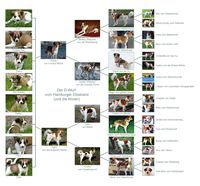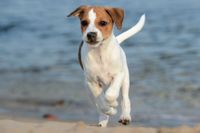The Health of the Kromfohrländer
The aim of this menu item is to inform, not to stir up fears or even to spread panic. Of course we hope that our dogs are healthy. For this we do everything that is possible and necessary. However, should a disease arise, it is sometimes vital and always helpful to be informed so that the earliest possible therapy can provide relief or even healing.
Every dog breeder should strive to create optimal conditions to enable his dogs and their offspring to have a long, healthy and happy dog life. At Prokromfohrländer, we take on this task as a matter of course and to the best of our knowledge and belief. Only stable dogs that are free of recognizable disease characteristics are used in breeding. Only dogs that have no common ancestors up to the great-grandparent generation (see the family tree of our D-litter as an example) and whose genetic relationship is as far apart as possible, as far as this is possible in such a small population (more information is available under breeding planning at Prokromfohrländer can be found here on our website).
A lot of information on the health and diseases of the Kromfohrländer can be found on the PK club website. The goal is to maintain a transparent handling of these topics. It says as follows:
"Unfortunately, due to pure breeding, there have been various diseases that occur frequently in the breed for more than 50 years, even if they have been spared from the so-called breed-typical diseases such as "Dachshund Lame" or "Hip Joint Dysplasia". These include epilepsy at Kromfohrländer, Hyperkeratosis, hereditary cataracts, and autoimmune-related diseases of various forms, which have been common in recent years. Particularly worrying is the significant increase in joint diseases, such as arthrosis, which begins at an uncharacteristically young age, and blood coagulation disorders. These are all diseases that also occur in almost every other dog breed and also in mixed breed dogs. In the past, a lot has been done in the RZV of the Kromfohrländer to get the health problems under control The annual health surveys documenting the state of health of the population, the introduction of the genotype procedure, which significantly reduced the occurrence of epilepsy, and a breeding limit, which regulates the use of breeding males, are exemplary here. Well-known cynologists, geneticists and population scientists are of the same opinion that a further increase in diseases in the Kromfohrländer can only be broken by blood freshening. (See also "The crossbreeding in pedigree dog breeding" by Dr. Sommerfeld-Stur). A targeted crossbreeding program would increase the genetic diversity that counteracts homozygosity. The effect would last for generations, bring about a significant improvement in the health situation and open up new possibilities for breeding planning." As is known, we decided many years ago to carry out such a cross-breeding project. Again, we would like to emphasize here that there is no guarantee for healthy dogs within this project, but we hope to improve the health situation within the population by increasing the genetic diversity.
Genetic tests have already been developed for some diseases. These include Digital Hyperkeratosis, Hyperuricurosia and von Willebrand Type I, to name just a few. Since all our dogs are subjected to a gene scan at Genoscoper in Finland before they are used for breeding (and also all puppies born in our club), we can rule out that their offspring are affected by these diseases, because we do not mate animals that share the same facilities for can pass on one of these diseases (see Genetics).
Unfortunately, such a genetic test does not yet exist for all diseases. Here the breeding control takes place via a breeding value estimation. For this purpose, the health data of the dogs and their ancestors, siblings and offspring are collected and evaluated. This can be used to determine the probabilities with which genetic defects are inherited from individual animals. Of course, we do not mate sick dogs. Let's take e.g. a dog suffering from a patellar luxation. This disease is known to be hereditary. And it is still after a successful operation, which is why we exclude such a dog from breeding. Likewise a dog that was born with a cleft palate, even if it was possible to close it surgically. A cystinuria, in which there is no longer any crystal formation in the urine after a change in diet still remains a cystinuria ….
There are also diseases that are inherited multifactorially, i.e. certain features occur through the interaction of genetic and non-genetic factors, as is usually the case with autoimmune diseases.
Without exception, every dog has facilities for genetic defects, pedigree dogs as well as mixed breeds. Almost all resulting diseases are inherited recessively, i.e. an individual must have the attachment from both parents to develop the disease (see genetics). The closer two animals are to each other, the greater the likelihood that they can carry and inherit the system for the same defect. That is why we look at both the genetic information and the family situation of the animals to be mated, in order to reduce the likelihood of an illness in our dogs to a minimum, if we can not rule it out (see litter planning at Prokromfohrländer ).
Early therapy can reduce suffering. That is why we would like to inform you about the possible occurrence of diseases. This is not about uncertainty, but about education. You can find much more information on health (and more) at Kromfohrländer on the familienkromi.de page. Below are some diseases that can occur in the Kromfohrländer. We can rule out the occurrence of some of them because of the genetic tests for our offspring that are mandatory for Prokromfohrländer, but the information on this should not be missing here:
>> Continue to "Castration - yes or no?"


